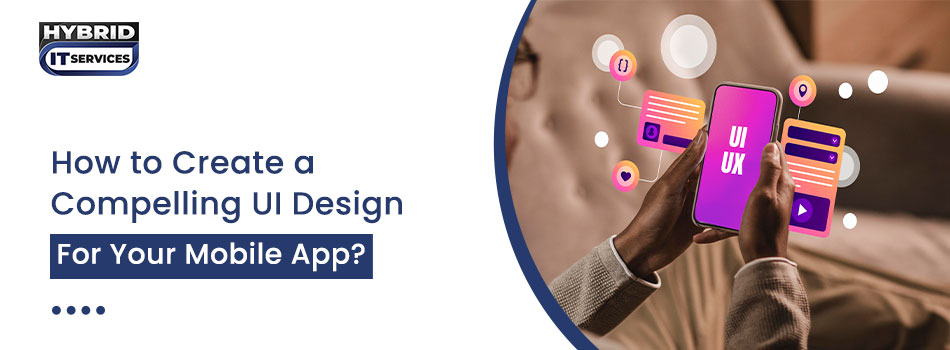From social networking to shopping, fitness tracking to finance management, mobile apps have revolutionized how we interact with technology. However, with the vast number of apps available, standing out in the crowded marketplace requires more than just a great idea. One of the key factors that can make or break an app is its User Interface (UI) design.
A compelling UI design not only enhances the user experience but also plays a crucial role in the app's success. This article delves into the importance of a compelling UI design for mobile apps and provides a detailed guide on how to create one.
Importance of Compelling UI Design for Mobile Apps
A compelling UI design is essential for mobile apps for several reasons.
First Impressions Matter
Users often form an opinion about an app within seconds of using it. A visually appealing and intuitive UI can create a positive first impression, encouraging users to explore the app further.
Ease of Use
A well-designed UI makes an app easy to use, which can significantly increase user retention. If users find the app frustrating or confusing, they are likely to abandon it.
Brand Reflection
The design of your app reflects your brand. A professional and aesthetically pleasing UI can enhance your brand image, making your app more trustworthy and reliable.
Competitive Edge
In a Saturated Market, a compelling UI can give your app a competitive edge. It can differentiate your app from others, attracting more users and retaining them longer.
You May Also Read: How Mobile App Development Services Improve User Engagement and Retention
How to Create a Compelling UI Design for Your Mobile App
Creating a compelling UI design involves several steps and considerations. Here are some key strategies:
Establish a Clear Mobile App Vision
Before you start designing, it's crucial to have a clear vision of what you want to achieve with your mobile app. Define the app's purpose, target audience, and the problems it aims to solve. This vision will guide your design decisions and ensure that all elements of the UI align with the overall goal of the app. Define the user journey to understand the different touchpoints and interactions users will have with the app.
This will help you design a UI that facilitates smooth navigation and enhances the user experience. Additionally, create user personas to represent different segments of your target audience. This will help you design a UI that caters to the specific needs and preferences of your users.
Enhance Your Design Through Iterative Processes
UI design is an iterative process. Instead of trying to perfect the design in one go, focus on continuous improvement through feedback and testing. Start with wireframes to outline the basic structure and layout of the app. Create prototypes to test the functionality and flow of the app. Use feedback from users and stakeholders to refine the design. Conduct regular user testing to identify pain points and areas for improvement.
- Wireframing and Prototyping: Start with wireframes to outline the basic structure and layout of the app. Create prototypes to test the functionality and flow of the app. Use feedback from users and stakeholders to refine the design.
- User Testing: Conduct regular user testing to identify pain points and areas for improvement. Incorporate user feedback into the design to enhance usability and satisfaction.
- Agile Approach: Adopt an agile approach to design, which allows for flexibility and quick adjustments based on user feedback and changing requirements.
You May Also Read: Things to Consider Before Developing a Mobile App | Essential App Development Tips
Consistency is Crucial
Consistency is crucial in UI design. A uniform design ensures that users can easily understand and navigate the app, providing a seamless experience.
- Design System: Create a design system that includes guidelines for typography, color schemes, button styles, and other UI elements. This ensures consistency across different screens and features of the app.
- Reusable Components: Use reusable components to maintain uniformity and streamline the design process. This also makes it easier to update the design in the future.
- Brand Identity Alignment: Ensure that the design elements align with your brand identity. Consistent use of colors, fonts, and logos reinforces brand recognition.
Perfect Your Splash Screen
The splash screen is the first thing users see when they open your app. A well-designed splash screen sets the tone for the entire user experience.
- Brand Integration: Incorporate your logo and brand colors into the splash screen to reinforce brand identity.
- Quick Loading: Ensure that the splash screen loads quickly and doesn't keep users waiting.
- Engaging Animations: Use animations and transitions to make the loading process more engaging.
Display Statistics Clearly
If your app involves presenting data and statistics, it's essential to do so in a clear and comprehensible manner.
- Data Visualization: Use charts, graphs, and other data visualization techniques to present statistics. Ensure that the visualizations are easy to understand and interpret.
- Interactive Elements: Incorporate interactive elements such as filters and drill-downs to allow users to explore the data in more detail.
- Relevance and Clarity: Avoid cluttering the screen with too much data. Present the most relevant information and provide options for users to access additional details if needed.
Optimize for Quick Page Load Times
Fast loading times are crucial for a positive user experience. Users are likely to abandon an app that takes too long to load.
- Image and Graphics Optimization: Compress images and optimize graphics to reduce loading times without compromising quality.
- Efficient Coding: Use efficient coding practices to minimize the app's loading time.
- Minimal Animations: Avoid unnecessary animations and transitions that can slow down the app.
- Progress Indicators: Use progress indicators to inform users that the app is loading. This can reduce frustration and keep users engaged.
Prioritize Mobile Accessibility
Accessibility is an important aspect of UI design.
- Screen Reader Compatibility: Ensure that your app is usable by people with disabilities. Ensure that your app is compatible with screen readers and other assistive technologies.
- High-Contrast Colors: Use high-contrast colors to make text and other elements readable for users with visual impairments.
- Intuitive Navigation: Design an intuitive and accessible navigation system. Use clear labels and provide alternative text for images and buttons.
Adhere to UI Design Best Practices
Adhering to established UI design principles can help you create a compelling and user-friendly app.
- Simplicity: Keep the design simple and uncluttered. Focus on essential features and avoid overwhelming users with too many options.
- Consistency: Maintain consistency in design elements and interactions throughout the app.
- User Feedback: Provide feedback to users through visual cues and notifications. This helps users understand the results of their actions and enhances the overall experience.
- User Control: Give users control over their actions. Allow them to undo actions, navigate freely, and customize settings according to their preferences.
Choose Hybrids IT's UI Design Services for Your Mobile App
Creating a compelling UI design requires expertise and experience. Hybrids IT offers professional UI design services tailored to your needs. With a team of skilled designers and a focus on user-centric design, Hybrids IT can help you create a visually appealing and functional app that stands out in the market. Their services include custom UI design, user research, prototyping and testing, and accessibility compliance. Our services include:
- Custom UI Design: Tailored designs that align with your brand and target audience.
- User Research: In-depth research to understand user needs and preferences.
- Prototyping and Testing: Iterative design process with continuous feedback and improvements.
- Accessibility Compliance: Designs that meet accessibility standards for a wider reach.
Conclusion
A compelling UI design is essential for the success of a mobile app. It enhances the user experience, increases retention, and reinforces your brand image. By following the strategies outlined in this article, you can create a UI design that is both visually appealing and functional. Remember, UI design is an ongoing process that requires continuous improvement and adaptation to user feedback. Partnering with professionals like Hybrids IT can further ensure that your app's UI design is top-notch and competitive in the market.






